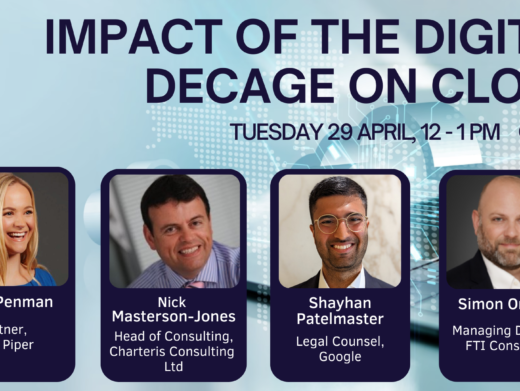In a study last year conducted by Enterprise Strategy Group and Clearwell Systems, of more than 100 enterprises and government agencies surveyed, 22% of respondents held the job title ‘E-Disclosure Manager’. Many readers may not have heard of this role, which is not surprising since this is a relatively new phenomenon spurred on by the data deluge most organisations are now facing. Legal and IT departments simply no longer have unlimited budgets to outsource e-disclosure – a problem made even worse by corporate data growth. In response to these proliferating costs, many organisations have begun taking some e-disclosure tasks in-house and there is a growing trend towards grooming proficient in-house leaders who are schooled in both legal and IT matters and who can oversee the e-disclosure process. In fact, 34% of respondents to the survey stated they ‘would hire more people and dedicate additional staff’ to deal with expected electronic discovery increases – organisations are willing to put skin in the game to make this change happen.
Planning for the E-Disclosure Manager Role
Before embarking on a career as an E-Disclosure Manager or considering the development of such a role in your organisation, there are a matters to consider. Thinking about them now will help IT and legal departments work hand-in-hand to build policies and execute them when litigation hits.
1. Get Proactive: Don’t wait for a crisis to erupt or when the team is under the pressure of a deadline to set policies for data collection, review and production. Come up with a set of agreed upon ground rules to avoid working at cross-purposes, making mistakes or missing deadlines. Explain and review early on how the processes should work, which department will own various phases of discovery, and who will oversee implementation of these policies. When an investigation presents itself, it is the E-Disclosure Manager’s responsibility to make sure each member of the team understands his or her role and what the legal department is trying to accomplish. Similarly, throughout the course of any given matter, the scope of an investigation could easily expand (and Murphy’s Law says it will). So, both groups must be prepared to turn on a dime as the number of custodians, data ranges or search topics expands.
2. Play Nice: Mend fences and get to know your neighbor. Traditionally, the crossover between legal and IT has been non-existent or minimal at best. The job of an E-Disclosure Manager is not only to create smooth running tactical operations, but also to cultivate a group that understands each other’s needs so they may better serve the other. Legal should get to know IT, and IT should understand legal. In the majority of cases, legal departments will generally have a rough idea which employees are associated with a legal matter, the time frame within which relevant information may have been produced, and keywords that are likely to lead to relevant data. Conversely, systems experts in IT are skilled at working with repositories of information, such as e-mail and file servers, and they will know where to find the information. Add into the mix, the advent of cloud computing and offsite repositories, like Sharepoint, and legal’s dependence on IT becomes even more critical.
3. Make It A Repeatable Process. E-disclosure isn’t a one-time event. It is an ongoing business process just like marketing, sales and finance. By investing in and creating repeatable processes, together IT and legal can work towards automating many of the time-consuming activities involved with responding to discovery requests. This up-front investment will pay dividends in the long run, and put the company at a significant competitive advantage.
Organisations are responding to the unabated growth of e-disclosure with the appointment of liaison officers like E-Disclosure Managers. This recent development will go a long way towards lowering costs and putting organisations in control of their own destiny – both financially and from a legal perspective. A more balanced division of labour in light of the increasing volumes of e-disclosure will ultimately benefit all parties involved.
Dean Gonsowski is Associate General Counsel for Clearwell Systems www.clearwellsystems.com. He is a member of The Sedona Conference Working Group on Electronic Document Retention and Production (WG1), the Electronic Discovery Reference Model (EDRM) and teaches a series of continuing legal education (CLE) courses on various topics.




